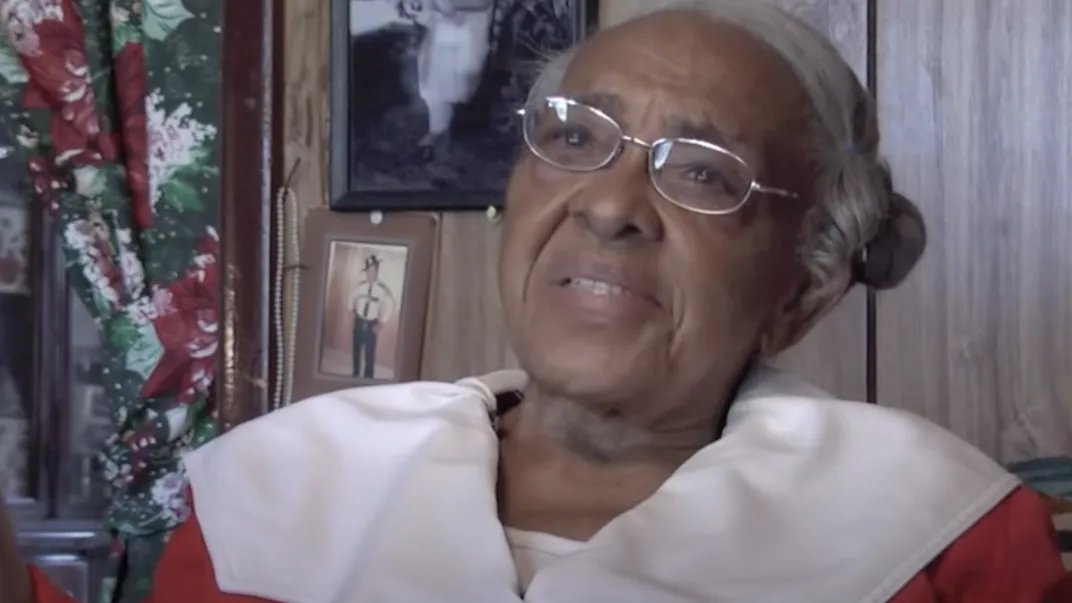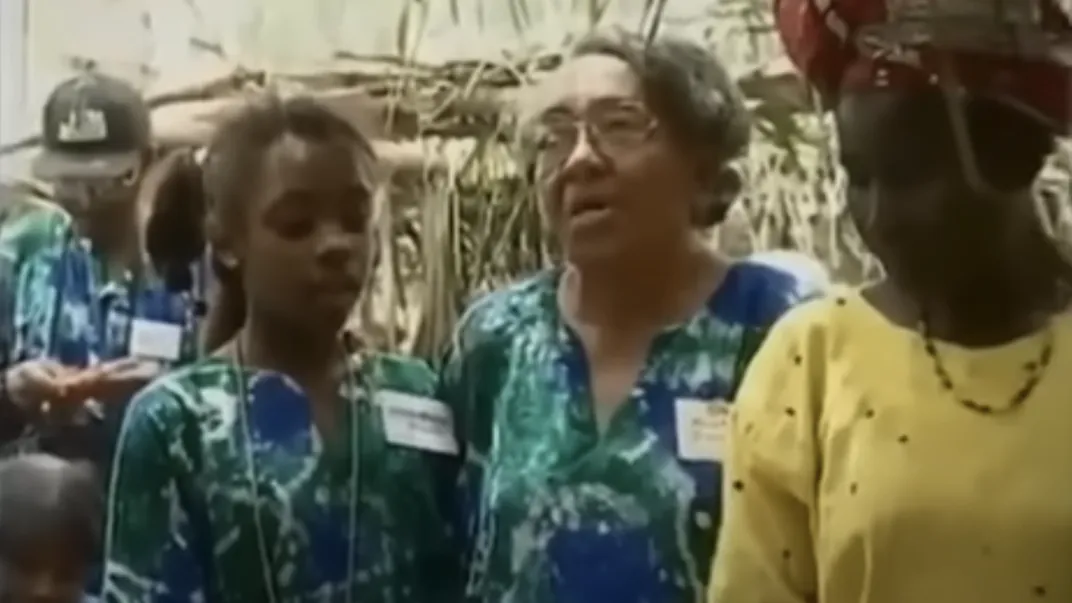In 1933, the pioneering Black linguist Lorenzo Dow Turner met an elderly Gullah Geechee woman named Amelia Dawley in a remote coastal village south of Savannah, Georgia. While Turner recorded, Dawley sang a song of unknown origin, passed down through the generations by her ancestors. Dawley didn’t know the song’s meaning, but a Sierra Leonean student who heard the recording recognized its lyrics as Mende, a major language in his home country. Turner published an English translation of the song in his 1949 book, Africanisms in the Gullah Dialect.
Decades later, anthropologist Joseph Opala came across Turner’s work. He eventually decided to travel through Sierra Leone with ethnomusicologist Cynthia Schmidt and native linguist Tazieff Koroma in an attempt to trace the provenance of the mysterious lyrics. After a long, fruitless search through humid country, Schmidt ended up in the isolated village of Senehun Ngola, where she met a local woman who had preserved a shockingly similar song that traced back hundreds of years.
“[Her] grandmother had taught her the song, and she had kept it alive by changing the words for other occasions,” says Schmidt.
Located on the Windward Coast of West Africa, the region now known as Sierra Leone was a key player in the trans-Atlantic slave trade. Westerners also referred to the area as the Rice Coast; as English abolitionist Thomas Clarkson wrote in 1788, the red rice found there was “finer in flavor, of a greater substance, more wholesome and capable of preservation, than the rice of any other country.”
/https://tf-cmsv2-smithsonianmag-media.s3.amazonaws.com/filer_public/c2/a1/c2a180db-3959-4995-b8f8-1676b717f14b/bunce_island_map.jpeg)
When slave traders arrived in Sierra Leone, they found a lush country of verdant forests, knobby mountains and waters thick with aquatic life. Cultivated rice fields and wild indigo sprawled across the landscape. Massive mangrove trees crowded the riverbanks, rendering certain villages “scarcely perceptible” and protecting their inhabitants from potential enslavers, who could pass “within a few yards of a town” and not suspect anything, wrote English physician Thomas Masterman Winterbottom in 1803.
Bunce Island, where captive West Africans were held in a stone fortress before being forced onto slave ships for the deadly journey across the Middle Passage, served as the center of the region’s slave trade. In 1791, Anna Maria Falconbridge, the wife of an English abolitionist, wrote about the unforgettable “sight of between two and three hundred wretched victims, chained and parceled out in circles, just satisfying the cravings of nature from a trough of rice placed in the center of each circle.”
In North America, wealthy rice planters whose plantations lined the Lowcountry—a region along Georgia and South Carolina’s coast that includes the Sea Islands—paid a premium for enslaved people from Sierra Leone. When slave ships docked, local newspapers reported their arrivals and made sure readers knew the enslaved people on board were from a part of Africa famed for its rice cultivation. A 1785 advertisement published in Charleston, South Carolina, for example, touted the sale of “Windward Coast Negroes, who are well acquainted with the culture of rice, arrived from B[u]nce Island.”
Between about 1750 and 1800, the slave trade brought thousands of West Africans to the Lowcountry, whose Sea Islands resembled the marshes of their homelands. These individuals’ diverse languages melded together, and a distinctive patois and culture started to emerge. Known as the Gullah Geechee, the community has preserved remnants of its African heritage through food, rituals and art—including Dawley’s ancestral song.
Turner, the scholar who first recorded Dawley’s melody, counted Zora Neale Hurston among his students. The Harlem Renaissance author later remembered Turner as the professor “who most influenced me,” a handsome, soft-spoken “Harvard man [who] knew his subject.”
After a chance conversation with two students at what is now South Carolina State University, where he was teaching summer school in 1929, Turner decided to focus his fieldwork on Gullah language and culture. Walking along the Lowcountry, Turner interviewed descendants of the enslaved, made careful notes about their dialect and songs, and took photos. Turner’s first wife, Geneva Townes Turner, helped him record Gullah sounds and even enrolled in phonetics classes to prepare for the research.
Musicologist Lydia Parrish, who was also studying the music of the formerly enslaved, drew Turner’s attention to Dawley’s song. In the summer of 1933, he met 52-year-old Dawley and her 11-year-old daughter, Mary, in Harris Neck, Georgia. Dawley told Turner about a song passed down by her paternal grandmother, Catherine, who had survived the Middle Passage and was enslaved by a Georgia plantation owner. Catherine had several children with her enslaver, including Dawley’s father, Mustapha Shaw, who served a soldier in the 33rd Regiment of the United States Colored Troops during the Civil War.
After Union Major General William Tecumseh Sherman completed his famous March to the Sea from Atlanta to Savannah in late December 1864, he issued a special order that set aside 400,000 acres of captured Confederate territory for redistribution to Black families. The plan didn’t last: President Andrew Johnson rescinded it in the fall of 1865, returning the land to its original owners. Shaw was one of the many freedmen who fought back against the reversal, which the newly emancipated “understood as an assault on their hard-won freedom,” wrote historian Allison Dorsey in a 2010 essay. But Shaw’s efforts were unsuccessful, so he returned his birthplace of Harris Neck, buying ten acres from none other than his father and former enslaver.
/https://tf-cmsv2-smithsonianmag-media.s3.amazonaws.com/filer_public/1f/ca/1fca97fe-b306-4b31-88c1-5461dcd79df7/amelia_dawley.jpg)
/https://tf-cmsv2-smithsonianmag-media.s3.amazonaws.com/filer_public/60/45/6045e18f-15ff-43cf-b0bd-17cb4e6ea869/lorenzo.jpg)
Turner’s July 31, 1933, recording finds Dawley sharing her family song, which helped her remember her mother, Tawba Shaw, and her paternal grandmother. Today, the aluminum disc is housed at Indiana University’s Archives of Traditional Music alongside 835 other recordings made by Turner between 1932 and 1960.
Until his death in 1972 at age 77, Turner remained dedicated to the study of Gullah and similar languages. His groundbreaking research showed that Gullah, long dismissed by white observers as simply “bad English,” was actually derived from more than 30 African languages.
The dialect’s existence speaks to “the strength of the people brought here as slaves,” Alcione Amos, curator of a past exhibition about Turner at the Smithsonian’s Anacostia Community Museum, told Smithsonian magazine in 2010. “They couldn’t carry anything personal, but they could carry their language. They thought everything was destroyed in the passage. But you can’t destroy people’s souls.”
Turner’s work was foundational for subsequent Black language scholars, including Opala, the anthropologist who identified the African counterpart to Dawley’s song. After graduating from college in 1974, Opala joined the Peace Corps, which shipped him off to Sierra Leone, where he worked with rice farmers before shifting focus to archaeology.
“The U.S. ambassador at that time, Michael Samuels, urged me to do an archaeological survey of Bunce Island”—the first of its kind, says Opala. Begun in 1976, the excavations “led to my efforts to find out where the enslaved people shipped from that island were taken.”
/https://tf-cmsv2-smithsonianmag-media.s3.amazonaws.com/filer_public/c0/b8/c0b82fd9-3efe-4387-887b-9286c086ec27/acm-acma_ph20037064314.jpg)
/https://tf-cmsv2-smithsonianmag-media.s3.amazonaws.com/filer_public/b5/82/b58238d9-9b5a-4f4a-9ee6-8e9f03b64acb/acm-acma_ph20037064309.jpg)
Ethnomusicologist Schmidt was teaching at Sierra Leone’s Fourah Bay College when Opala requested her help in studying Turner’s recordings of Gullah stories and songs. The pair spent six years collaborating with Sierra Leonean linguist Koroma and Mende man Edward Benya to reconsider and correct Turner’s original translation. Ultimately, the group settled on this phrasing:
A wa ka, mu mone; kambei ya le’i; lii i lei tambee
A wa ka, mu mone; kambei ya le’i; lii i lei ka
Haa so wolingoh sia kpande wilei
Haa so wolingoh, ndohoh lii, nde kee
Haa so wolingoh sia kuhama ndee yia
Translated into English, the lyrics read:
Everyone come together, let us struggle; the grave is not yet finished; let his heart be perfectly at peace.
Everyone come together, let us struggle; the grave is not yet finished; let his heart be very much at peace.
Sudden death commands everyone’s attention like a firing gun.
Sudden death commands everyone’s attention, oh elders, oh heads of the family.
Sudden death commands everyone’s attention like a distant drumbeat.
The breakthrough came when Koroma recognized a word from the song as a Mende dialect from southern Sierra Leone. In 1990, the researchers traveled around the country’s Pujehun District, playing the song for villagers in hopes of finding someone who recognized the words. Schmidt says she and her colleagues acknowledged that this was a “remote possibility,” but after many weeks, they found a small village, Senehun Ngola, and a woman named Baindu Jabati who astonished them by singing a nearly identical version of the song.
/https://tf-cmsv2-smithsonianmag-media.s3.amazonaws.com/filer_public/dc/3f/dc3ff22d-75de-49b2-9804-a3633b1e89fe/baindu-jabati-mary-moran_001.jpeg)
Jabati revealed that the tune—taught to her by her grandmother—was originally a funeral elegy. As Jabati explained in the 1998 documentary The Language You Cry In, her grandmother said that “those who sing this song are my brothers and sisters.” Given the similarities between the two songs, the researchers concluded that Dawley’s ancestors hailed from this specific area of Sierra Leone.
Schmidt and Opala reached out to Dawley’s daughter, by then married and known as Mary Moran, to share their discovery. But the outbreak of the Sierra Leone Civil War in 1991 prevented Moran and Jabati from connecting in person. During the conflict, Jabati was enslaved by rebels, who killed several of her family members and razed her village. By 1997, the war had eased enough for Moran to travel to Senehun Ngola, where her meeting with Jabati was recorded for The Language You Cry In.
Anthropologist Joseph Opala and Ethnomusicologist Cynthia Schmidt were the ones who — after hearing Dr. Turner’s recording — went to Sierra Leone to search for anyone who might recognize the lyrics sung in America by a Gullah Geechee family at least 200 years. pic.twitter.com/Q15HUGfSFp
— GullahMuseumSC (@GullahSc) September 6, 2020
The documentary concluded with a message from the village’s blind, 90-year-old chief, Nabi Jah, who encapsulated hundreds of years of trauma by saying, “You can identify a person’s tribe by the language they cry in.”
Since the song contains about 50 words, it’s “almost certainly the longest text in an African language ever preserved by an African American family,” says Opala. “By comparison, [Roots author] Alex Haley was led to his roots in the Gambia by about five or six words in Mandinka.”
In her 1986 book, Radiance From the Waters: Ideals of Feminine Beauty in Mende Art, art historian Sylvia Ardyn Boone wrote that the Mende people remember “a vast storehouse of information” through the use of song. According to Boone, when someone dies, “the ear remains alive.” The Mende repeat the mantra “Ngoli nda ii haa ma,” which translates to “There is no death [within] the ear.”
In addition to shedding new light on Dawley’s story, Opala joined other scholars in tracing the ancestry of a 10-year-old African girl named Priscilla, kidnapped in 1756 from Sierra Leone, to a 21st-century woman living in South Carolina. Today, Dawley’s family keeps her legacy alive with repeated visits to Sierra Leone and ongoing charitable support. “The 1619 Project” miniseries, based on the New York Times investigation of the same name, shared the story of Dawley’s father, Shaw, and featured interviews with some of her descendants.
Identifying the origins of Dawley’s song “solidifies my identity, because I know where I came from,” says Dawley’s great-nephew, Winston Relaford. “I am no longer another person with a general origin. I now know who I am.” For Relaford and his relatives, the lyrics mean neither “slavery nor the width or depth of the ocean could keep [them] separated” from their Sierra Leonean heritage.
:focal(787x340:788x341)/https://tf-cmsv2-smithsonianmag-media.s3.amazonaws.com/filer_public/c8/d4/c8d4c566-9ae3-456e-9321-de1df5ae1f7c/gullah.jpg)


